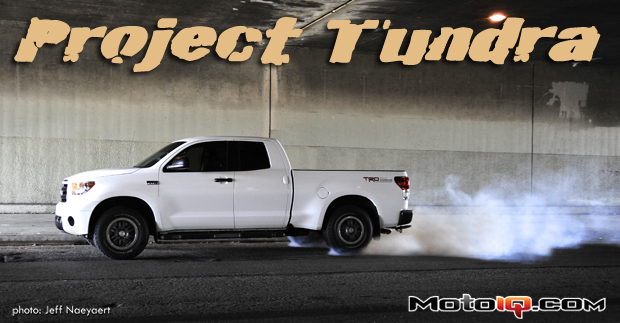,
|
To validate the TRD kit we subjected our Tundra to hard use over the entire summer, we towed over the notorious Baker grade in 110-degree heat without skipping a beat and over the equally notorious Grapevine blasting the AC without the temperature needles for the engine and transmission deviating from their normal position one bit. We did not do this just once but all summer long with no hiccups. We not only towed over the grades but we also did it at pretty high speeds. With the supercharger the rig could go up the steepest grades maintaining highway speed at literally 1/8 throttle! No more cowering and praying in the truck lane watching every gauge and crossing fingers! Like we said the stock Tundra is no slouch but a supercharged Tundra makes hard work effortless.
|
| The big double pass heat exchanger for the water to air intercooler is installed in front of the radiator. The intercooler core itself is located inside the blower casing. The heat exchanger gets plenty of airflow here. |
 |
| An electric water pump keeps Toyota long life pre-mixed coolant flowing through the system. The intercooler is so effective, it hardly ever gets hot and it quickly cools down when it does. |
 |
| The pump is neatly installed in an unobtrusive place, low enough to be self priming. |
 |
| The intercooler coolant lines are all OEM quality molded parts with factory hold downs and anti abrasion sleeves. All OEM level stuff here, nothing Mickey Mouse. |
 |
| The factory lower airbox is retained but the filter element is replaced with this washable and reusable TRD high flow element with a larger capacity upper airbox. We left the bigger power duct from our previously installed TRD cold air intake in place so the airbox inlet is bigger than the TRD kit. |
|
We did attempt to dyno the Tundra but we had a hard time on Technosquare’s Superflow dyno. The Tundra kept trying to spin its tires and climb over the rollers where the tires would perilously start rubbing on the deck plates in front of the rollers. Even when restrained with two sets of straps the Tundra kept tying to break free. We were able to do a couple of partial pulls where the truck spun up 405 whp and 432 lb feet of torque, a full 100 more than it had previously. |
| We mean partial runs because the Tundra spun its wheels on the rollers at lower RPM so we had to gently roll into the throttle and not give full throttle until past the rated torque peak. Also we stopped after two passes because, well, we were scared. A late model Toyota usually takes several passes for the ECU’s self-learning to settle down on the dyno and start producing its best power but we were to scared to keep making pulls. Nevertheless we believe TRD’s power claims as our previous dyno testing showed that the drivetrain absorbs about 25% of the power the engine produces at the crank. |




